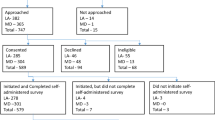Abstract
Since 2005, the Ohio Pregnancy Risk Assessment Monitoring System (PRAMS) has used a prepaid phone card incentive in an effort to increase survey response. Although Ohio PRAMS has generally achieved an overall response rate of 70%, African American participation has been significantly lower, a persistent problem documented by other PRAMS states. We examined the effect of a gift card incentive compared to the standard phone card on African American response. Sampled women in the African American stratum of Ohio PRAMS were randomly assigned to either the experimental (n = 276) or control (n = 274) incentive ($10 CVS gift card or 30-min prepaid phone card, respectively). Response rates were calculated for the total number of sampled African American women during the study period. Partial or full completion of the survey instrument by mail or phone was considered a response. Logistic regression was used to identify independent predictors of response. Variables examined included age, education, ethnicity, marital status, smoking status, birth weight, Women Infants and Children (WIC) enrollment, prenatal care, parity, and incentive assignment. The overall unweighted response rate was significantly higher in the experimental group (60.5 vs. 48.5%, P = .002). Maternal and infant characteristics were similar between groups. Logistic regression modeling revealed that having more than 12 years of education (OR = 2.46, 1.56–3.89), gift card incentive (OR = 1.46, 1.02–2.10), and enrollment in WIC (OR = 1.57, 1.05–2.35) were independent predictors of increased survey response. Use of a $10 CVS gift card incentive in place of a prepaid phone card can positively impact African American response in PRAMS.

Similar content being viewed by others
References
Centers for Disease Control and Prevention PRAMS model surveillance protocol phase V [Internet]. (2009). Atlanta, GA: Centers for Disease Control and Prevention [cited 1 Jul 2009]. Available from: http://www.cdc.gov/prams.
Gilbert, B. C., Shulman, H. B., Fischer, L. A., et al. (1999). The pregnancy risk assessment monitoring system (PRAMS): Methods and 1996 response rates from 11 states. Maternal and Child Health Journal, 3, 199–209.
Shulman, H. B., Gilbert, B. C., & Lansky, A. (2006). The pregnancy risk assessment monitoring system (PRAMS): Current methods and evaluation of 2001 response rates. Public Health Reports, 121, 74–83.
Satia, J. A., Galanko, J. A., & Rimer, B. K. (2005). Methods and strategies to recruit African Americans into cancer prevention surveillance studies. Cancer Epidemiology, Biomarkers and Prevention, 14, 718–731.
Cynamon, M. L., Kulka, R. A., (eds.) (2001). Seventh Conference on Health Survey Research Methods; 1999 Sep 24–47; Williamsburg, VA. Hyattsville, MD: National Center for Health Statistics; 2001 Feb. 247 p. (DHHS Pub No. (PHS) 01-1013).
Church, A. H. (1993). Estimating the effect of incentives on mail survey response rates: A meta-analysis. Public Opinion Quarterly, 57, 62–79.
Edwards, P., Roberts, I., Clarke, M., et al. (2002). Increasing response rates to postal questionnaires: Systematic review. British Medical Journal, 324, 1183–1192.
Ryu, E., Couper, M. P., & Marans, R. W. (2005). Survey incentives: Cash vs. in-kind; face-to-face vs. mail; response rate vs. nonresponse error. International Journal of Public Opinion Research, 18, 89–106.
Beebe, T. J., Davern, M. E., Call, K. T., et al. (2005). Increasing response rates in a survey of Medicaid enrollees: The effect of a prepaid monetary incentive and mixed modes (mail and telephone). Medical Care, 34, 411–414.
Blumberg, S. J., & Luke, J. V. (2009). Wireless substitution: Early release of estimates from the National Health Interview Survey, July-December 2008. Hyattsville, MD: National Center for Health Statistics.
Pre-paid phone cards [Internet]. (2008). Washington, DC: Federal Communications Commission [cited 3 Mar 2010]. Available from: http://www.fcc.gov/cgb/consumerfacts/prepaidcards.html.
Infant mortality task force preliminary report [Internet]. (2009). Columbus, OH: Ohio Department of Health [cited 3 Mar 2010]. Available from: http://www.odh.ohio.gov/ASSETS/90FB34BBA3A3438B8FE19119D546F56C/Draft%20Recommendations.pdf.
Dillman, D. A. (2002). Mail and internet surveys: The tailored design method (2nd ed.). New York: Wiley.
Vittinghoff, E., Glidden, D. V., Shiboski, S. C., et al. (2005). Regression methods in biostatistics. New York: Springer.
Sun, G. W., Shook, T. L., & Kay, G. L. (1996). Inappropriate use of bivariable analysis to screen risk factors for use in multivariable analysis. Journal of Clinical Epidemiology, 49, 907–916.
Acknowledgments
The Ohio PRAMS project and this study were supported in part by grant No. 1 UR6 DP000469‐01 from the US Centers for Disease Control and Prevention. We would like to acknowledge Jacqueline Bennett and Carrie Hornbeck for their involvement in logistical and data collection aspects of this project.
Disclaimer
The views expressed in this article are those of the authors and do not necessarily reflect the position or policy of the Ohio Department of Health.
Author information
Authors and Affiliations
Corresponding author
Rights and permissions
About this article
Cite this article
Liu, S.T., Geidenberger, C. Comparing Incentives to Increase Response Rates Among African Americans in the Ohio Pregnancy Risk Assessment Monitoring System. Matern Child Health J 15, 527–533 (2011). https://doi.org/10.1007/s10995-010-0609-4
Published:
Issue Date:
DOI: https://doi.org/10.1007/s10995-010-0609-4




